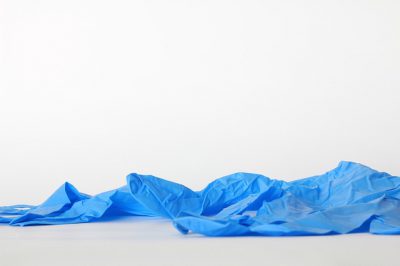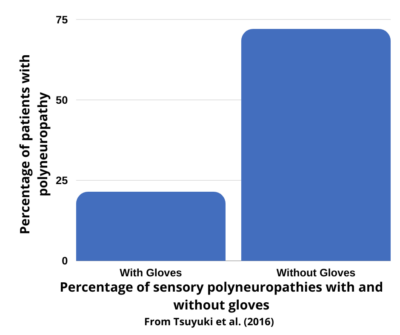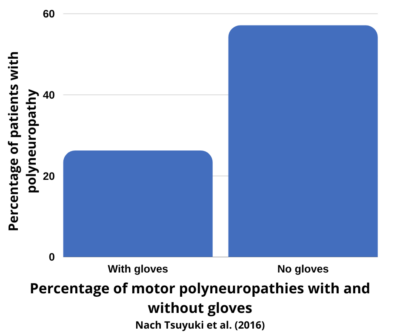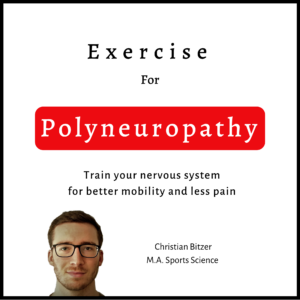Gloves for chemotherapy – a simple trick with huge…
- 21. March 201718. November 2024
- by Christian Bitzer
Prevent polyneuropathy with gloves during chemotherapy!
Doctors are trying to to help patients with chemotherapy - but unfortunately often unintentionally and unavoidably harm them: chemotherapy has severe side effects, one of which is polyneuropathy. But now a study shows there may be a simple, risk-free, low-cost way to reduce the incidence of polyneuropathy significantly. The crucial tool - rubber gloves - costs just a few cents ...

Briefly summarized
Wearing compression gloves during chemotherapy infusion can significantly reduce the risk of polyneuropathy. Simple surgical gloves are sufficient for this purpose. These should be selected one size too small. Also, two gloves should be worn on top of each other to achieve sufficient compression.
Amazing help from gloves during chemotherapy infusion
Until now, doctors and therapists have been relatively powerless against polyneuropathy triggered by chemotherapy. There were no means to prevent polyneuropathy and hardly any to treat it once it occurred. However, there is new hope. Now, a Japanese study led by Shigeru Tsuyuki of Red Cross Hospital in Osaka has come up with a solution that is as amazingly simple as it is effective: gloves. No, not high-tech, fully digitalized gloves 4.0, but just normal surgical gloves for a few cents a pair.

90 minutes, amazing effect
The Japanese scientists had their subjects wear the surgical gloves while administering the drug. Starting 30 minutes before the administration of chemotherapy, during the 30 minutes of administration and 30 minutes afterwards. So all in all, just 90 minutes for a surprising, unexpectedly great effect.
The trick
Because now, of course, everyone wonders why simple gloves can prevent polyneuropathy: There was a trick to it. The patients did not wear gloves of their actual size, but one size smaller. And they wore not one pair, but two. At this point, every experienced nurse recognizes the active principle behind it: Compression. Which is obvious, of course, but what science would like to confirm through additional studies.
You can also help yourself against polyneuropathy with the right exercise!
Try it for yourself
For the time being, this further clarification can be dispensed with in the treatment of cancer patients, because the effect of the simple gloves in the Japanese study during chemotherapy was enormous: the incidence of chemotherapy-induced polyneuropathy fell from 76.1 percent to 21.4 percent for sensory polyneuropathies and from 57.1 percent to 26.2 percent for motor polyneuropathies. That's stunning. And all because of a pair of gloves; more precisely: because of two pairs.

Brilliant design
The design of the study was brilliant in order to avoid confounding (falsified results): It was not tested as usual with a test group and a control group, but much simpler: All subjects wore the gloves on one hand only. The other remained without treatment - and suffered. This may be inconvenient for those affected, but it is practically ideal for proving efficacy.
The principle of action of the gloves in chemotherapy
The compression provided by the gloves reduces blood flow: less chemical agent is flushed into the fingers and thus the nerves of the fingers are also less damaged. If you are worried about not enough blood reaching your hands: No, a surgical glove, even one size too small and worn twice, cannot constrict a human hand to the point of causing damage. Quite the opposite. Which is not a question anyway, because: Nobody forces patients to put on the glove. If patients start to feel uncomfortable with the compression, they can remove the gloves at any time. The only important thing is: there is no risk if he or she keeps the gloves on during the administration of chemotherapy.
Ice gloves during chemotherapy have the same effect
By the way, another Japanese study shows that the same effect can be achieved by cold (Kanbayashi et al. 2020). To do this, the scientists gave a group of test subjects cooling gloves that resemble a cold pack into which you put your hand. They wore these for 60 minutes while receiving chemotherapy. A second group received compression gloves, which they used exactly as described here. The result of the two groups was almost identical.
So if you have access to such cold gloves you can choose what you are more comfortable. If you suffer from latex allergy you should also try to get ice gloves. Otherwise, you can simply take the rubber gloves described.
Why hasn't everyone been doing this for a long time?
If a simple glove works so brilliantly, why don't all clinics and practices have it put on? Because the Japanese study is brand new in terms of scientific time spans: it was only published in September last year. If you are the first person in your practice or on your ward to find out about it: Please talk about it!
For one simple reason: this is the only way the interested party will find out about it. That was also the case for me: I got the tip about the study from Dr. Isabell Pfeiffer, who works at Celgene in Munich. If you would like to read the study: click here.
Pass it on!
Now it is a matter of spreading the good news to as many people as possible as quickly as possible. So that no human being has to suffer unnecessarily. And so that the glove trick can be tested in practice. This is the only way to get useful feedback, which I am of course very interested in. Why don't you write me what you think about it and/or what the discussion among your colleagues has revealed? Email
Or share this article.
By the way, here is a detailed article on exercises for polyneuropathy due to chemotherapy
If you are interested in physical training despite cancer you will find detailed information here: Training against cancer
